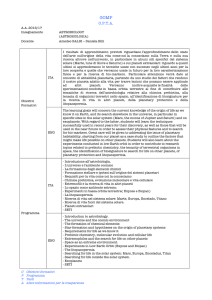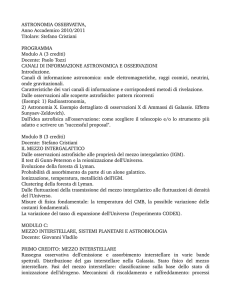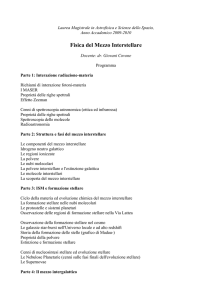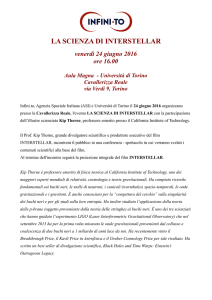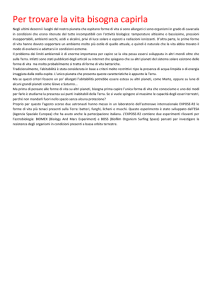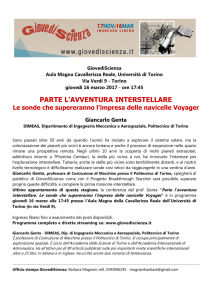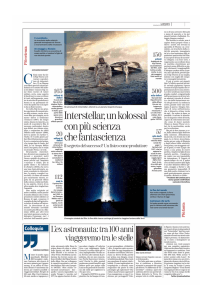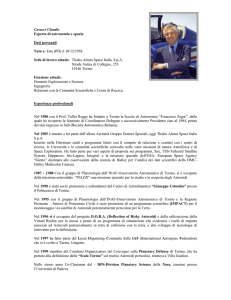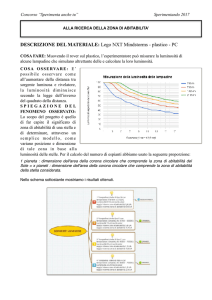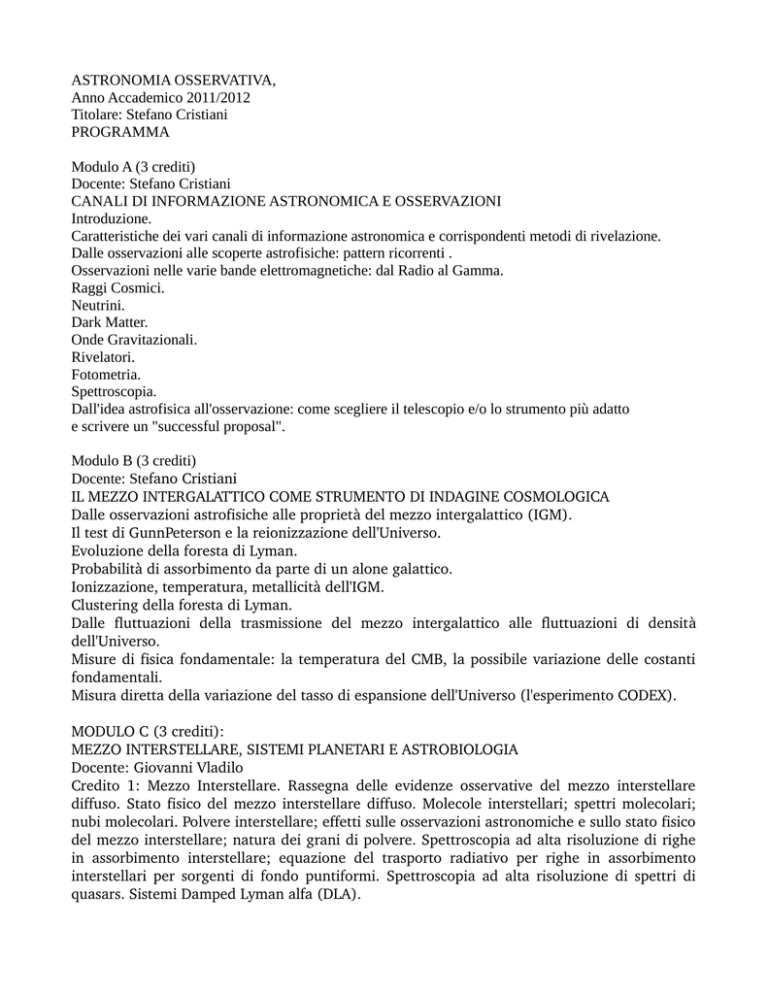
ASTRONOMIA OSSERVATIVA,
Anno Accademico 2011/2012
Titolare: Stefano Cristiani
PROGRAMMA
Modulo A (3 crediti)
Docente: Stefano Cristiani
CANALI DI INFORMAZIONE ASTRONOMICA E OSSERVAZIONI
Introduzione.
Caratteristiche dei vari canali di informazione astronomica e corrispondenti metodi di rivelazione.
Dalle osservazioni alle scoperte astrofisiche: pattern ricorrenti .
Osservazioni nelle varie bande elettromagnetiche: dal Radio al Gamma.
Raggi Cosmici.
Neutrini.
Dark Matter.
Onde Gravitazionali.
Rivelatori.
Fotometria.
Spettroscopia.
Dall'idea astrofisica all'osservazione: come scegliere il telescopio e/o lo strumento più adatto
e scrivere un "successful proposal".
Modulo B (3 crediti)
Docente: Stefano Cristiani IL MEZZO INTERGALATTICO COME STRUMENTO DI INDAGINE COSMOLOGICA
Dalle osservazioni astrofisiche alle proprietà del mezzo intergalattico (IGM). Il test di GunnPeterson e la reionizzazione dell'Universo. Evoluzione della foresta di Lyman. Probabilità di assorbimento da parte di un alone galattico. Ionizzazione, temperatura, metallicità dell'IGM. Clustering della foresta di Lyman. Dalle fluttuazioni della trasmissione del mezzo intergalattico alle fluttuazioni di densità dell'Universo. Misure di fisica fondamentale: la temperatura del CMB, la possibile variazione delle costanti fondamentali. Misura diretta della variazione del tasso di espansione dell'Universo (l'esperimento CODEX). MODULO C (3 crediti): MEZZO INTERSTELLARE, SISTEMI PLANETARI E ASTROBIOLOGIA Docente: Giovanni Vladilo Credito 1: Mezzo Interstellare. Rassegna delle evidenze osservative del mezzo interstellare diffuso. Stato fisico del mezzo interstellare diffuso. Molecole interstellari; spettri molecolari; nubi molecolari. Polvere interstellare; effetti sulle osservazioni astronomiche e sullo stato fisico del mezzo interstellare; natura dei grani di polvere. Spettroscopia ad alta risoluzione di righe in assorbimento interstellare; equazione del trasporto radiativo per righe in assorbimento interstellari per sorgenti di fondo puntiformi. Spettroscopia ad alta risoluzione di spettri di quasars. Sistemi Damped Lyman alfa (DLA). Credito 2: Pianeti e Sistemi Planetari. Rassegna delle principali proprietà fisiche del Sistema Solare. Pianeti rocciosi e giganti: caratteristiche interne e superficiali. Satelliti naturali. Asteroidi e comete. Meteoriti e loro classificazione. Metodi osservativi di pianeti extrasolari; parametri fisici misurabili, bias osservativi. Principali risultati degli studi di esopianeti. Osservazioni di atmosfere planetarie. Vincoli osservativi sulle fasi di formazione planetaria: eccessi infrarossi, dischi circumstellari; vincoli ottenuti dallo studio dei pianeti extrasolari. Credito 3: Astrobiologia e Abitabilità Planetaria. Introduzione all'astrobiologia. Principali proprietà chimiche della vita terrestre. La vita terrestre come paradigma di esobiologia. Ambienti abitabili: l'esempio della Terra. Condizioni estreme di abitabilità; organismi estremofili. Abitabilità planetaria: fattori astronomici e geofisici. L'origine della vita nel contesto dell'astrobiologia. Principali tappe dell'evoluzione della vita terrestre. Ricerca di ambienti abitabili e vita nel Sistema Solare. Abitabilità di pianeti extrasolari. Ricerche di biomarcatori nelle atmosfere planetarie. Abitabilità Galattica.
OBSERVATIONAL ASTRONOMY Stefano Cristiani SYLLABUS PART A (3 credits)
CHANNELS OF ASTRONOMICAL INFORMATION
Lecturer: S.Cristiani
Introduction Characteristics of the various channels of astronomical information and corresponding detection
methods.
From observations to astrophysical discoveries: recurrent patterns.
Observations in electromagnetic bands: from radio to gamma.
Cosmic Rays.
Neutrinos.
Dark Matter.
Gravitational waves.
Detectors.
Imaging.
Spectroscopy.
From the astrophysical idea to observations: how to choose the telescope and/or the best suited
instrument and write a successful proposal.
PART B (3 credits)
THE INTERGALACTIC MEDIUM AS A COSMOLOGICAL TOOL
Lecturer: S.Cristiani
From astrophysical observations to the properties of the intergalactic medium (I GM). The Gunn­Peterson test and the reionization of the Universe. Evolution of the Lyman forest. Probability of absorption of a galaxy halo. Ionization, temperature, metallicity of the IGM. Clustering of the Lyman forest. From the fluctuations of the IGM transmission, to the the density fluctuations of the Universe. Measurements of fundamental physics: the temperature of the CMB, the possible variation of the fundamental constants. The direct measurement of the variation of the expansion rate of the universe (the CODEX experiment). PART C (3 credits)
INTERSTELLAR MEDIUM, PLANETARY SYSTEMS AND ASTROBIOLOGY
Lecturer: G.Vladilo
1st credit: The Interstellar Medium. Observational review of the diffuse interstellar medium (ISM). Physical state of the ISM. Interstellar molecules; molecular spectra; molecular clouds. Interstellar dust; dust effects on astronomical observations; dust effects on the physical state of the ISM; nature of dust grains. High resolution spectroscopy of interstellar absorption lines; radiative transfer equation of interstellar absorption lines in the case of point­like background sources. High resolution spectroscopy of quasar and gamma­ray­source spectra. Damped Lyman alpha systems. 2nd credit: Planets and Planetary Systems. Review of the main physical properties of the Solar System. Rocky and giant planets: surface characteristics and inner structure. Natural satelites. Asteroids and comets. Meteorites and their classification. Observational methods of extrasolar planets; observable physical quantities; observational biases. Main results obtained from surveys of exoplanets. Observations of planetary atmospheres. Observational constraints on planetary formation: infrared excesses, circumstellar disks; constraints obtained from studies of extrasolar planets. 3d credit: Astrobiology and Planetary Habitability. Introduction to astrobiology. Main chemical properties of terrestrial life. Terrestrial life as a paradigm in esobiology. Habitable environments: the example of the Earth. Extreme conditions of habitability: extremophile organisms. Planetary habitability: astronomical and geophysical factors. The origin of life in the framework of astrobiology. Main stages of the evolution of terrestrial life. Search for habitable environments and life in the Solar System. Habitability of extrasolar planets. Search for biomarkers in planetary atmospheres. Galactic habitability.

